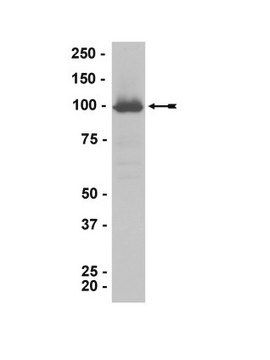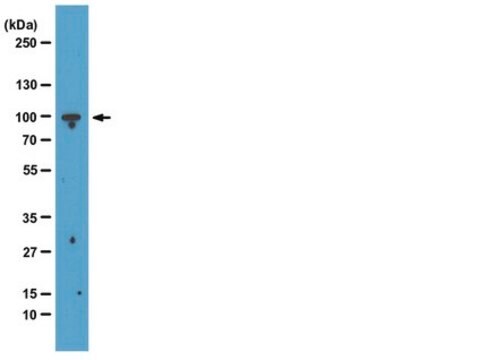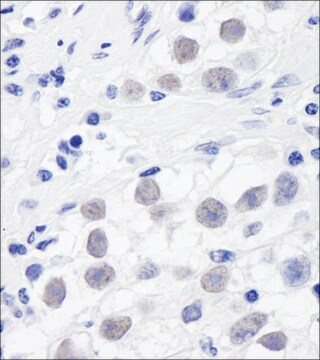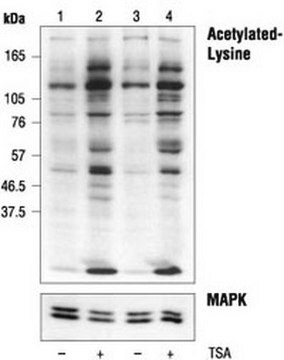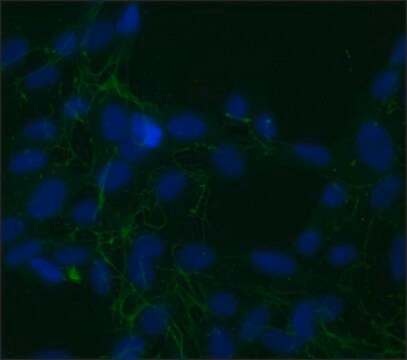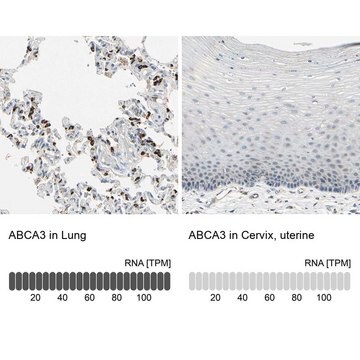MABE1073
Anti-acetyl SMC3 Antibody (Lys105/106), clone 21A7
clone 21A7, from mouse
Synonym(s):
Structural maintenance of chromosomes protein 3, Lys105/106 acetylated, Bamacan, Lys105/106 acetylated, Basement membrane-associated chondroitin proteoglycan, Lys105/106 acetylated, Chondroitin sulfate proteoglycan 6, Lys105/106 acetylated, Chromosome-as
About This Item
ELISA
WB
ELISA: suitable
western blot: suitable
Recommended Products
biological source
mouse
Quality Level
antibody form
purified immunoglobulin
antibody product type
primary antibodies
clone
21A7, monoclonal
species reactivity
human
species reactivity (predicted by homology)
nonhuman primates (based on 100% sequence homology), Xenopus (based on 100% sequence homology), bovine (based on 100% sequence homology), mouse (based on 100% sequence homology), rat (based on 100% sequence homology)
technique(s)
ChIP: suitable (ChIP-seq)
ELISA: suitable
western blot: suitable
isotype
IgG2bκ
NCBI accession no.
UniProt accession no.
shipped in
ambient
target post-translational modification
acetylation (Lys105/Lys106)
Gene Information
human ... SMC3(9126)
General description
Specificity
Immunogen
Application
Chromatin Immunoprecipitation (ChIP) Analysis: A representative lot detected enhanced SMC3 occupancy at target chromatin sites in HDAC8-null HCT116 cells than wild-type HCT-116 cells (Rahman, S., et al. (2015). Proc. Natl. Acad. Sci. U. S. A. 112(36):11270-11275).
ChIP-seq Analysis: A representative lot detected SMC3 chromosome 11 enrichment sites, including 81% of Rad21 target sites and 70% of Esco1 target sites, by ChIP-seq (Rahman, S., et al. (2015). Proc. Natl. Acad. Sci. U. S. A. 112(36):11270-11275).
Western Blotting Analysis: A representative lot detected SMC3 Lys105/106 acetylation in HeLa cells. ESCO1 or ESCO2 depletion by shRNA treatment reduced SMC3 Lys105/106 acetylation level, while dual ESCO1/2 depletion resulted in most profound SMC3 Lys105/106 acetylation reduction (Rahman, S., et al. (2015). Proc. Natl. Acad. Sci. U. S. A. 112(36):11270-11275).
Epigenetics & Nuclear Function
Quality
Western Blotting Analysis: A 1:1,000 dilution of this antibody detected a reduced SMC3 Lys105/106 acetylation in 10 µg of lysate from N-acetyltransferase ESCO1-knockout human retinal epithelial pigment (REP) cells than in lysate from wild-type REP cells.
Target description
Physical form
Storage and Stability
Other Notes
Disclaimer
Not finding the right product?
Try our Product Selector Tool.
Storage Class
12 - Non Combustible Liquids
wgk_germany
WGK 1
flash_point_f
Not applicable
flash_point_c
Not applicable
Certificates of Analysis (COA)
Search for Certificates of Analysis (COA) by entering the products Lot/Batch Number. Lot and Batch Numbers can be found on a product’s label following the words ‘Lot’ or ‘Batch’.
Already Own This Product?
Find documentation for the products that you have recently purchased in the Document Library.
Our team of scientists has experience in all areas of research including Life Science, Material Science, Chemical Synthesis, Chromatography, Analytical and many others.
Contact Technical Service